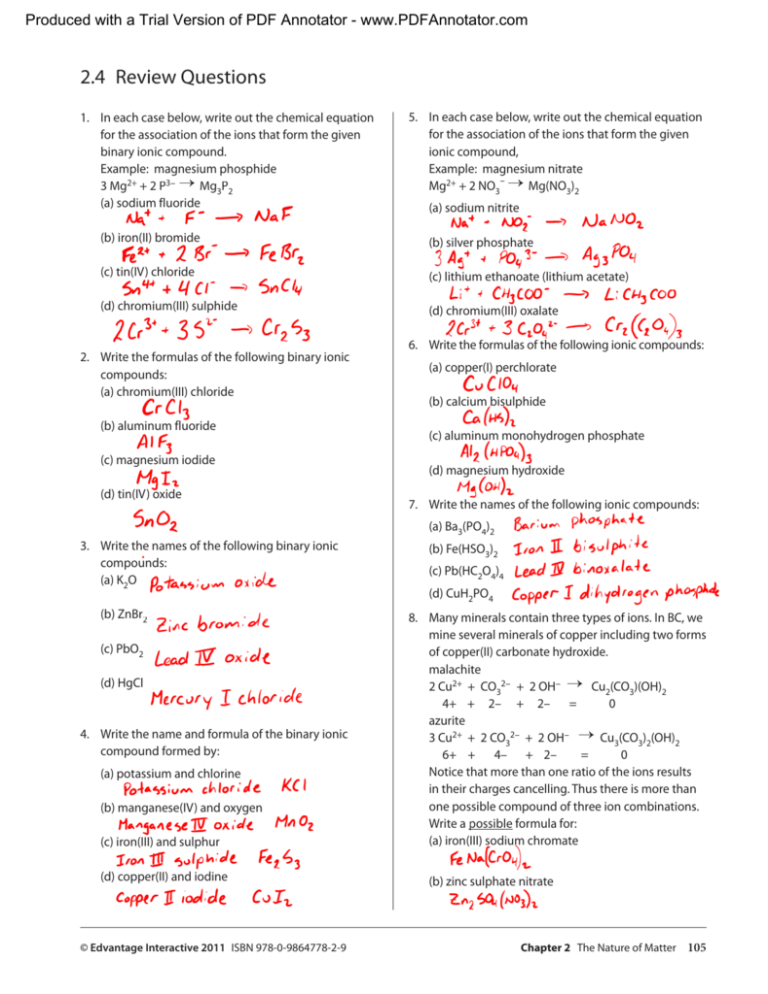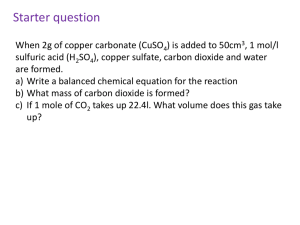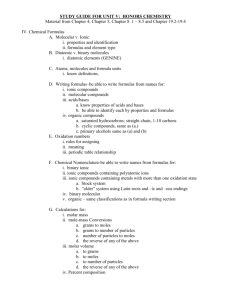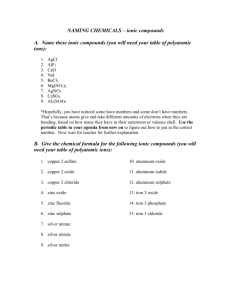Answers to Review 2.4 from Textbook
advertisement

Produced with a Trial Version of PDF Annotator - www.PDFAnnotator.com 2.4 Review Questions 1. In each case below, write out the chemical equation for the association of the ions that form the given binary ionic compound. Example: magnesium phosphide 3 Mg2+ + 2 P3− → Mg3P2 (a) sodium fluoride 5. In each case below, write out the chemical equation for the association of the ions that form the given ionic compound, Example: magnesium nitrate − Mg2+ + 2 NO3 → Mg(NO3)2 (a) sodium nitrite (b) iron(II) bromide (b) silver phosphate (c) tin(IV) chloride (c) lithium ethanoate (lithium acetate) (d) chromium(III) sulphide (d) chromium(III) oxalate 2. Write the formulas of the following binary ionic compounds: (a) chromium(III) chloride (b) aluminum fluoride (c) magnesium iodide (d) tin(IV) oxide 6. Write the formulas of the following ionic compounds: (a) copper(I) perchlorate (b) calcium bisulphide (c) aluminum monohydrogen phosphate (d) magnesium hydroxide 7. Write the names of the following ionic compounds: (a) Ba3(PO4)2 3. Write the names of the following binary ionic compounds: (a) K2O (b) ZnBr2 (c) PbO2 (d) HgCl 4. Write the name and formula of the binary ionic compound formed by: (a) potassium and chlorine (b) manganese(IV) and oxygen (c) iron(III) and sulphur (d) copper(II) and iodine © Edvantage Interactive 2011 ISBN 978-0-9864778-2-9 (b) Fe(HSO3)2 (c) Pb(HC2O4)4 (d) CuH2PO4 8. Many minerals contain three types of ions. In BC, we mine several minerals of copper including two forms of copper(II) carbonate hydroxide. malachite 2 Cu2+ + CO32− + 2 OH− → Cu2(CO3)(OH)2 4+ + 2– + 2– = 0 azurite 3 Cu2+ + 2 CO32− + 2 OH− → Cu3(CO3)2(OH)2 6+ + 4– + 2– = 0 Notice that more than one ratio of the ions results in their charges cancelling. Thus there is more than one possible compound of three ion combinations. Write a possible formula for: (a) iron(III) sodium chromate (b) zinc sulphate nitrate Chapter 2 The Nature of Matter 105 Produced with a Trial Version of PDF Annotator - www.PDFAnnotator.com 9. Write the formulas of the following molecular compounds: 15. Write the formulas of the following acids: (a) hydrobromic acid (a) chlorine monoxide (b) chromic acid (b) tetraphosphorus hexaoxide (c) chloric acid (c) arsenic pentafluoride (d) hypochlorous acid (d) nitrogen tri-iodide 10. Write the names of the following molecular compounds: (a) P3Br5 16. Write the names of the following acids: (a) H2S (b) HClO4 (b) B2H6 (c) HNO2 (c) SO3 (d) HSCN (d) CF4 11. Write the formulas of the following hydrated salts: (a) sodium sulphate decahydrate 17. Write the formulas of the following variety of compounds: (a) potassium oxide (b) permanganic acid (b) calcium chloride dihydrate (c) sulphur dioxide (c) copper(II) acetate monohydrate (d) ammonium carbonate (d) chromium(III) chloride hexahydrate (e) iron(II) sulphate heptahydrate 12. Write the names of the following hydrated salts: (a) Cd(NO3)2, 4H2O (f) hydrocyanic acid (b) Na2HPO4, 7H2O (g) sulphur hexafluoride (c) CuSO4, 5H2O (h) calcium acetate monohydrate (d) Fe(NO3)3, 9H2O (i) chromium(III) bisulphite 13. Why is a hydrate not a mixture of salt and water? (j) magnesium hydroxide 14. Suggest why hydrate formulas are written in the manner they are, rather than bracketing the number of water molecules in the formula (e.g., SrCl2, 6H2O rather than SrCl2(H2O)6). 106 Chapter 2 The Nature of Matter © Edvantage Interactive 2011 ISBN 978-0-9864778-2-9







